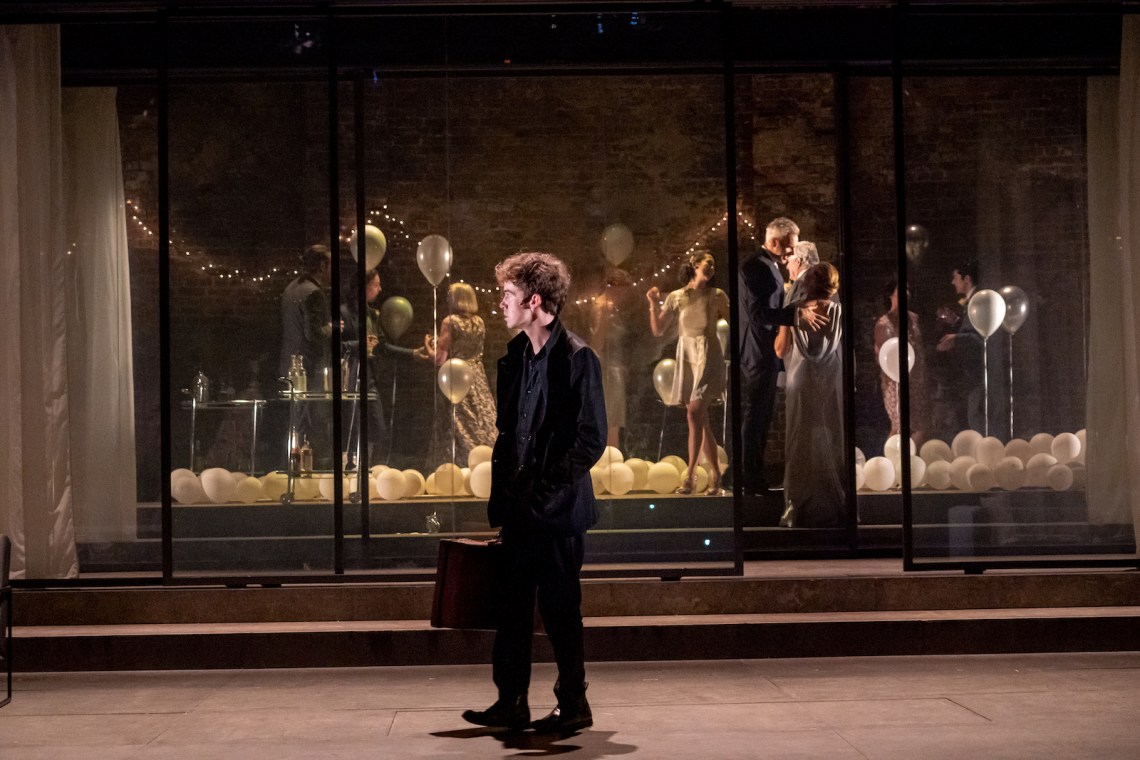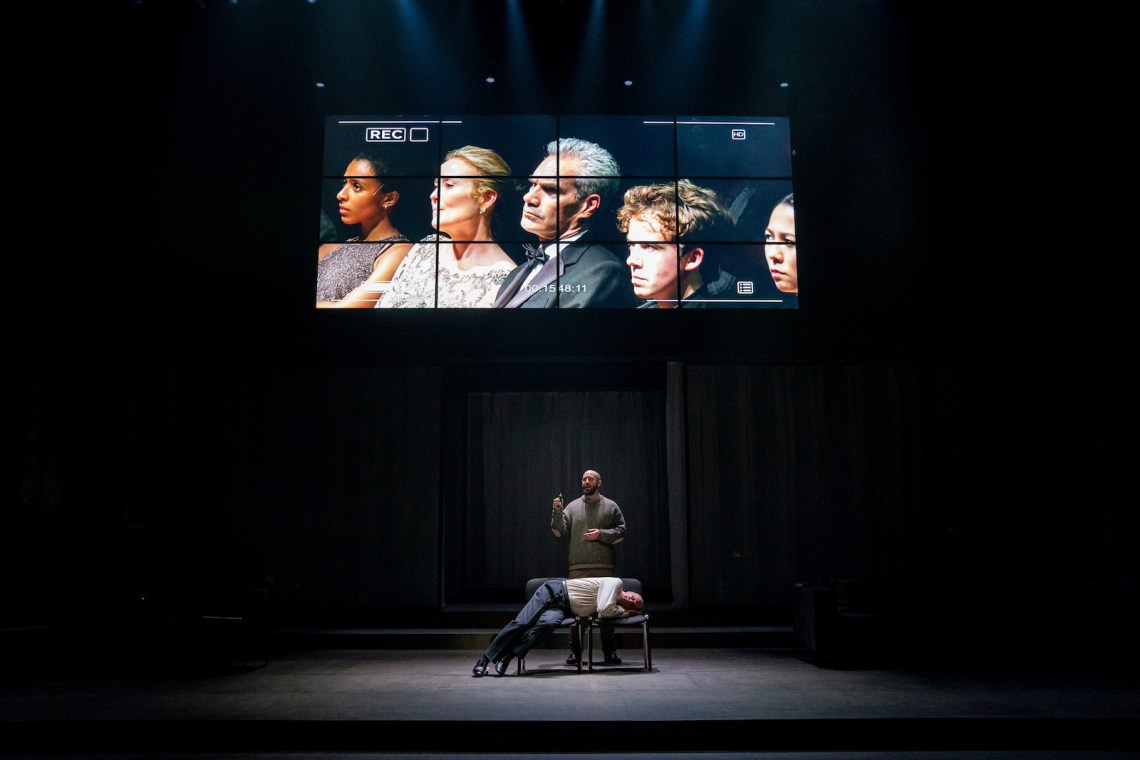There is no outside, or so it can sometimes seem, to William Shakespeare’s Hamlet. Like its main character, the play is constantly reflecting on itself and holding up mirrors that also indict its audience in that relentless self-examination. Hiding behind a curtain to observe Hamlet’s mad rantings, Claudius fantasizes that he will be “seeing unseen,” but the play refuses the idea that there is any such thing as a detached observer. The New York run of Robert Icke’s production, which premiered at London’s Almeida Theatre in 2017, is staged in the Wade Thompson Drill Hall of the Park Avenue Armory. With its long lobby lined with portraits of proud military officers of yesteryear, the Armory almost seems to belong to the world within Shakespeare’s tragedy: a once-martial setting in which several generations of people have assembled to watch a play.
The set, designed by Hildegard Bechtler, is sleek and emphatically modern: at center stage are low, steel-framed chairs and a couch, with cushions that seem to retain no memory of anyone ever having sat on them. In the opening scene, the night watchmen observe large security monitors, on which the Ghost—this “thing,” “illusion,” “apparition”—soon appears. When the lights go up on the court, the department of corporate planning seems to be throwing a party: in a giant glass aquarium–like enclosure in the recesses of the stage, glossy white balloons float upward, reminding everyone to keep it merry in merry-ish olde England (or Denmark or New York), while the king and queen dance somewhat drunkenly and gropingly to the swaying rhythms of “Spirit on the Water,” one of the Bob Dylan songs that make up the production’s soundtrack:
I wanna be with you in paradise
And it seems so unfair
I can’t go to paradise no more
I killed a man back there
If, as Hamlet will claim, every play holds a “mirror up to nature,” the reflection that this production offers—heads up, party people—is not flattering. It shows a society in which platitudes provide the thinnest possible cover for violence. King Claudius (Angus Wright) is attempting to conceal, beneath truisms that everything will always be the same (it is a “common theme,” he intones, that all fathers must die), the fact that he has committed a crime: he has murdered his brother, old King Hamlet, and married the queen. So hasty was this hostile takeover and merger that “the funeral baked meats / did coldly furnish forth the marriage tables.”
When Prince Hamlet (Alex Lawther) enters this scene of corporate doublespeak, where a man can “smile and smile and be a villain,” his opening gambit is to contrast the falsity of the image-oriented court with his own painful interiority (“I have that within which passeth show”). With his Harry Styles–esque tousled hair, Lawther might initially seem to be a teen martyr to misunderstood selfhood. But he quickly develops a more challenging and complex interpretation of his character, inviting us to see how Hamlet’s self-disgust has become indistinguishable from arrogance, and how his rejection of the most basic social bonds has made him oddly like those who have victimized him. The difference between Hamlet and Claudius soon diminishes; Hamlet and the king’s long-term advisor Polonius (Peter Wight) even seem, at one moment when they face off, to be physically mirroring each other.
Alternately tightly coiled and oddly listless, Lawther’s Hamlet curves his body this way and that, as though his “too too solid flesh” has already begun to melt. His tempo is often meaningfully out of sync with that of the other characters, suggesting with every lugubrious or frenzied gesture that he is trying to exist in a separate medium from them. But has it ever been true that, as Satan puts it in Paradise Lost, “the mind is its own place” and “not to be chang’d by Place or Time”? It is certainly not true in Icke’s Denmark, where even this intellectual prince fails to find mental autonomy: “O God, I could be bounded in a nutshell and count myself a king of infinite space—were it not that I have bad dreams.”
Precisely when we should pity him most, Lawther’s Hamlet becomes scariest. When Ophelia (Kirsty Rider) returns his letters, Hamlet holds a fist to her face. Talking with his mother, Gertrude (Jennifer Ehle), in her bedroom, he promises to set up a mirror that will expose “the inmost part” of her. The text presents Gertrude as unsure how to interpret the violent implications of the line, but this production’s Hamlet holds a gun to her head. In another scene, we see Rosencrantz (Calum Finlay) and Guildenstern (Jacqueline Jarrold, filling in for Tia Bannon), who look like they have just returned from a semester abroad, joking around with Hamlet. Instead of showing the rich social and intellectual ties that bind the younger generation in troubled resistance to the older generation, the scene depicts Hamlet as a spoiled, vindictive boy who threatens his college friends and then flicks them away.
Advertisement
“Am I a coward?” Hamlet asks in his third soliloquy. On delivering that line, Lawther turns directly to the audience and waits for a response. When the late David Warner tried the same move in Peter Hall’s 1965 production at the Royal Shakespeare Theatre in Stratford-upon-Avon, someone in the audience shouted back, “Yes!” No man is an island—except, it seems, on the island of Manhattan. When no one responded at the Armory on the night I saw the play, Lawther’s Hamlet turned away and beat at his own head with his fists. There is no opting out of the general rottenness.
Or almost none. Alternative versions of being human do occasionally appear onstage. At the beginning of the play-within-the-play, the Player King (David Rintoul, who also plays the Ghost) and the Player Queen (Marty Cruickshank) enact a scene of child-raising through a spare and gentle pantomime. Cruickshank performs the Player Queen beautifully, seeming to come from another world than the one we have been watching. With her flat shoes, gray bob, and bright eyes, she conveys the pace, air, and intimacy of another era. (The so-called dumb show is, in fact, a more archaic form of drama, a remnant of the medieval morality play.) The Player Queen’s actions express neither inwardness nor outwardness but a third mode of selfhood: interpersonal tenderness. The quiet intimacy she evokes proves ephemeral, however, disappearing almost immediately into the flashing, loud, multi-screened, relentlessly entertaining, gun-pointing, action-packed, corporate-messaged world of the production.
Ross Waiton’s gravedigger offers a similarly moving reprieve. He plays his scene not for laughs but with the restrained professionalism and watchful gravitas of a laborer. Explaining the timetable by which bodies rot (not all at the same rate, it turns out), the gravedigger points out that the tanner’s skin is so saturated with chemicals that it lets in water more slowly. When he speaks these lines, he touches his dirty bare belly, and we may recall that Shakespeare’s own father was a glover whose craft involved tanning animal skins. Class awareness runs deep in this play, affecting not just the living, who are “crawling between earth and heaven,” but also the dead whose bodies are lying in the dirt.
*
Most productions of Hamlet make cuts (a full reading of the text would take over four hours), and Icke’s production already runs long by contemporary standards: three hours and forty minutes with two intermissions. Yet some of the chosen cuts undermine the play’s resistance to the centripetal vortex that is Hamlet.
That the play makes us think it is about one young man’s alienation has been part of its seductive appeal for generations. Hamlet, the longest role in any Shakespeare play, is perhaps most famous for his soliloquies. Augustine first coined this term in his Soliloquia; the word comes from the Latin solus, alone, and loqui, to speak. Augustine’s work is written as a dialogue because the saint reports feeling like he is talking with someone else even though he is alone. He names the other voice Reason but also says that the conversation occurs “with God’s help.” But Hamlet presents a more secular universe, lacking any divine presence that might mediate the prince’s aloneness. When it becomes unclear whether the Ghost is real or a figment of Hamlet’s own psychic disturbance, the character begins to seem mad. This absence is what makes Hamlet’s social relationships critical: he may have no God, but he does have friends—Ophelia and Horatio, most importantly. In this production, however, these roles and also that of Gertrude are not always endowed with enough substance to resist the black hole of Hamlet’s alienated selfhood. Icke’s version is thus more male and more exclusively about an individualistic self than the play is, giving in to Hamlet’s fantasy that, as he puts it, “I am alone.”
The play may be a mirror held up to nature, but a mirror is a tricky thing—and not always a medium for rigorous self-reflection. The Elizabethans knew well that Vanity also holds a mirror and that Narcissus is captivated by his own reflection. When the royal court is watching the play-within-the-play, a big screen shows a livestream of not just the actors’ faces, but, behind them, ours as well: masked-up New Yorkers who are expecting, like the play’s aristocrats, entertainment and maybe flattery. Icke’s multiple screens seem like an overly literal and familiar way for us to discover ourselves onstage. The question is whether such production choices help show us the “form and pressure” of our era, or whether they merely provide the opportunity for—please direct your focus at the camera and gaze broodingly—another selfie.
Advertisement
The Bob Dylan soundtrack is a more surprising experiment. Soulful and catchy, songs like “Spirit on the Water” and “Not Dark Yet” contribute to the production’s interrogation of what interiority is and how to represent it: If inner truth passeth show, as Hamlet claims, what does it mean to showeth it? To hear the twang of incongruity between these two “bards”—the one Renaissance, the other modern—is to perceive the dilemma of representing complex interiority now, at least in a production that wants to show the form and pressure of an era saturated with mass media.
What does it mean that these songs get more airtime in this production than Ophelia’s? Her haunting songs—mostly cut here—describe the costs of human nefariousness with elliptical phrases that are more suggestive than declarative. The songs are “nothing” in themselves, says one onstage observer, but onlookers are moved to try to understand them and “botch the words up fit to their own thoughts.” This line provides a further meditation on how theater makes meaning through the interplay of audiences and performers: it does so by producing readings that are also—perhaps necessarily—misreadings.



